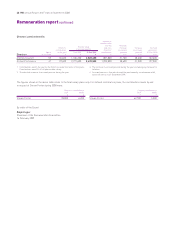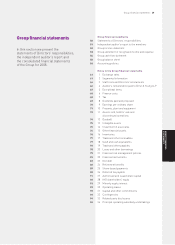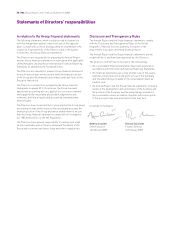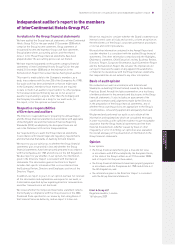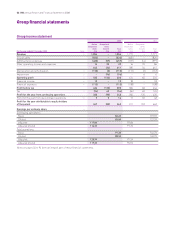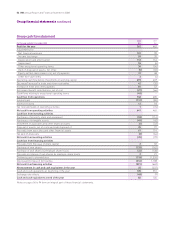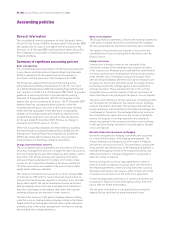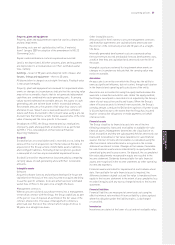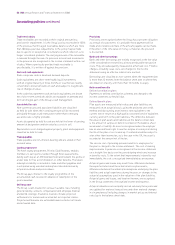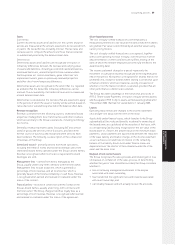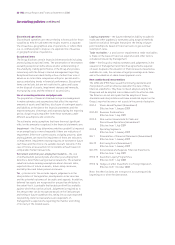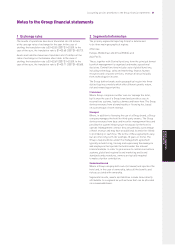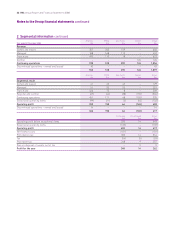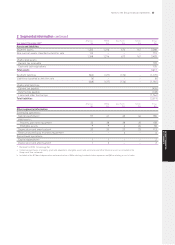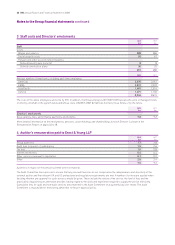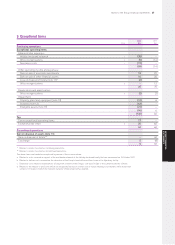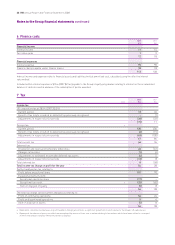Holiday Inn 2008 Annual Report Download - page 60
Download and view the complete annual report
Please find page 60 of the 2008 Holiday Inn annual report below. You can navigate through the pages in the report by either clicking on the pages listed below, or by using the keyword search tool below to find specific information within the annual report.58 IHG Annual Report and Financial Statements 2008
Trade receivables
Trade receivables are recorded at their original amount less
provision for impairment. It is the Group’s policy to provide for 100%
of the previous month’s aged receivables balances which are more
than 180 days past due. Adjustments to the policy may be made
due to specific or exceptional circumstances when collection is no
longer considered probable. The carrying amount of the receivable
is reduced through the use of a provision account and movements
in the provision are recognised in the income statement within cost
of sales. When a previously provided trade receivable is
uncollectable, it is written off against the provision.
Cash and cash equivalents
Cash comprises cash in hand and demand deposits.
Cash equivalents are short-term highly liquid investments
with an original maturity of three months or less that are readily
convertible to known amounts of cash and subject to insignificant
risk of changes in value.
In the cash flow statement cash and cash equivalents are shown
net of short-term overdrafts which are repayable on demand and
form an integral part of the Group’s cash management.
Assets held for sale
Non-current assets and associated liabilities are classified
as held for sale when their carrying amount will be recovered
principally through a sale transaction rather than continuing
use and a sale is highly probable.
Assets designated as held for sale are held at the lower of carrying
amount at designation and fair value less costs to sell.
Depreciation is not charged against property, plant and equipment
classified as held for sale.
Trade payables
Trade payables are non-interest-bearing and are stated at their
nominal value.
Loyalty programme
The hotel loyalty programme, Priority Club Rewards, enables
members to earn points, funded through hotel assessments,
during each stay at an IHG branded hotel and redeem the points at
a later date for free accommodation or other benefits. The future
redemption liability is included in trade and other payables and
is estimated using eventual redemption rates determined by
actuarial methods and points values.
The Group pays interest to the loyalty programme on the
accumulated cash received in advance of redemption of the
points awarded.
Self insurance
The Group is self-insured for various insurable risks including
general liability, workers’ compensation and employee medical
and dental coverage. Insurance reserves include projected
settlements for known and incurred but not reported claims.
Projected settlements are estimated based on historical trends
and actuarial data.
Provisions
Provisions are recognised when the Group has a present obligation
as a result of a past event, it is probable that a payment will be
made and a reliable estimate of the amount payable can be made.
If the effect of the time value of money is material, the provision
is discounted.
Bank and other borrowings
Bank and other borrowings are initially recognised at the fair value
of the consideration received less directly attributable transaction
costs. They are subsequently measured at amortised cost. Finance
charges, including issue costs, are charged to the income
statement using an effective interest rate method.
Borrowings are classified as non-current when the repayment date
is more than 12 months from the balance sheet date or where they
are drawn on a facility with more than 12 months to expiry.
Retirement benefits
Defined contribution plans
Payments to defined contribution schemes are charged to the
income statement as they fall due.
Defined benefit plans
Plan assets are measured at fair value and plan liabilities are
measured on an actuarial basis, using the projected unit credit
method and discounting at an interest rate equivalent to the
current rate of return on a high quality corporate bond of equivalent
currency and term to the plan liabilities. The difference between
the value of plan assets and liabilities at the balance sheet date
is the amount of surplus or deficit recorded on the balance sheet
as an asset or liability. An asset is recognised when the employer
has an unconditional right to use the surplus at some point during
the life of the plan or on its wind up. If a refund would be subject to
a tax other than income tax, as is the case in the UK, the asset is
recorded at the amount net of the tax.
The service cost of providing pension benefits to employees for
the year is charged to the income statement. The cost of making
improvements to pensions is recognised in the income statement
on a straight-line basis over the period during which any increase
in benefits vests. To the extent that improvements in benefits vest
immediately, the cost is recognised immediately as an expense.
Actuarial gains and losses may result from: differences between
the expected return and the actual return on plan assets;
differences between the actuarial assumptions underlying the plan
liabilities and actual experience during the year; or changes in the
actuarial assumptions used in the valuation of the plan liabilities.
Actuarial gains and losses, and taxation thereon, are recognised
in the Group statement of recognised income and expense.
Actuarial valuations are normally carried out every three years and
are updated for material transactions and other material changes
in circumstances (including changes in market prices and interest
rates) up to the balance sheet date.
Accounting policies continued


